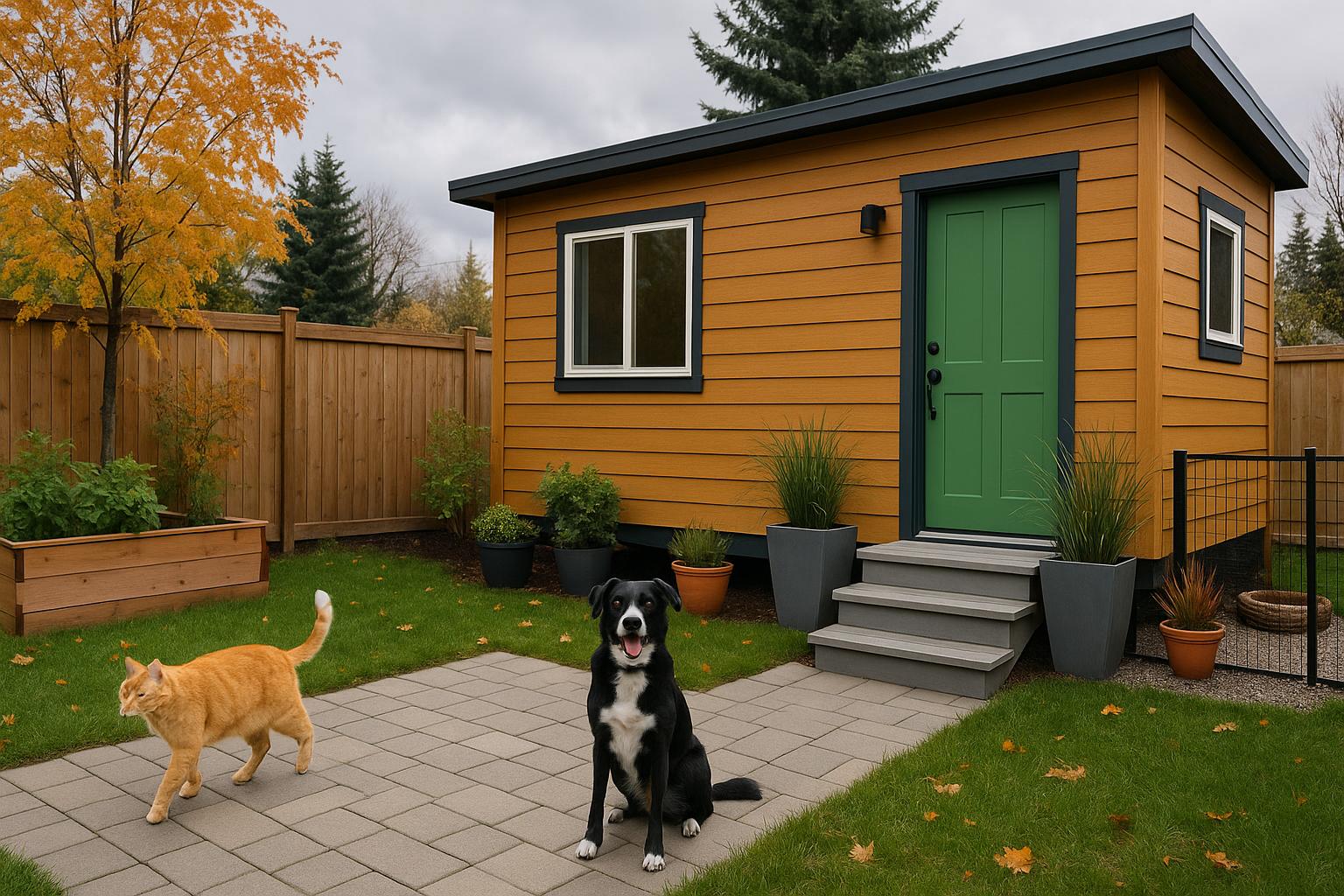
Pet-Friendly Design for Tiny Homes and ADUs: Creating Outdoor Spaces That Work in the Canadian Climate
Estimated reading time: 8 minutes
Key Takeaways
- Essential Design Elements: Safety, accessibility, durability, and stimulation are crucial to creating pet-friendly spaces in compact homes.
- Climate Challenges: Canadian winters, heavy snow, and seasonal extremes require innovative outdoor designs.
- Smart Utilization of Space: Vertical spaces and multi-use areas maximize tiny home and ADU areas for both pets and their owners.
- Durable Materials: Weather-resistant options like composite decking and pressure-treated wood ensure longevity and safety.
- Real-World Solutions: Case studies and practical tips demonstrate how thoughtful design can enhance pet well-being year-round.
Table of contents
- Understanding Pet-Friendly Design Principles
- Challenges and Considerations for Outdoor Spaces in the Canadian Climate
- Designing Outdoor Spaces for Tiny Homes and ADUs
- Practical Tips for Creating Safe and Accessible Outdoor Pet Areas
- Enhancing Outdoor Spaces for Pet Enrichment and Fun
- Case Studies and Examples
- Conclusion
- Frequently Asked Questions
Understanding Pet-Friendly Design Principles
Pet-friendly design for tiny homes and ADUs starts with four key elements: safety, accessibility, durability, and stimulation. Each is essential when space is limited and the Canadian climate demands resilience.
1. Safety: Enclosures and Materials
- Secure, sturdy boundaries to prevent escapes.
- Self-closing gates to keep pets safely contained.
- Non-toxic building materials and finishes for a healthy environment.
- Avoid sharp corners and exposed hardware that can injure playful paws.
Learn more from United Tiny Homes, Canadian Interiors, and AduStart.
2. Accessibility: Universal Pet Features
- Gentle ramps instead of stairs for older pets or those with mobility issues.
- Wide, slip-resistant pathways designed for safe movement.
- Pet-sized doors or gates that allow independent access while ensuring safety.
- Height-adjustable feeding and watering stations for ease of use.
Research insights from Bring Fido highlight the importance of these accessibility features.
3. Durability: Surfaces Built to Last
- Select weather-resistant materials like composite decking and pressure-treated lumber.
- Use stainless steel, aluminium, or heavy-duty plastics for outdoor pet features.
- Apply exterior-grade paints or stains to prevent moisture damage.
For additional guidance, visit Canadian Interiors and AduStart.
4. Stimulation: Play and Enrichment
- Include interactive play areas such as tunnels, climbing racks, and scratching posts.
- Create designated digging boxes or sand pits to satisfy natural instincts.
- Incorporate wall-mounted shelves or perches to add vertical play opportunities.
For more inspiration, check out Havenn and United Tiny Homes.
Challenges and Considerations for Outdoor Spaces in the Canadian Climate
Tiny homes and ADUs in Canada face unique challenges including:
- Long, harsh winters with extended periods of cold and icy conditions.
- Heavy snowfall that can block exits and obscure pet zones.
- Seasonal extremes that require versatile, all-season design strategies.
Learn more at Canadian Interiors and AduStart Winter-Proofing.
Designing Outdoor Spaces for Tiny Homes and ADUs
Compact outdoor spaces demand creative solutions that make every square foot count:
- Vertical space utilization: Install cat shelves, wall-mounted scratchers, or stacking platforms.
- Multi-purpose areas: Divide patios into zones with retractable fencing and versatile furniture arrangements.
- Adaptable zones: Use fold-out feeding stations and modular play areas that easily adjust with the seasons.
For additional ideas, visit Havenn, United Tiny Homes, and AduStart.
Practical Tips for Creating Safe and Accessible Outdoor Pet Areas
- Fencing and Safe Enclosures: Use modular, portable panels and dig-proof barriers to keep pets contained.
- Landscaping for Pet Health: Select non-toxic plants and durable ground covers like gravel or artificial turf that withstand the Canadian climate.
- Shelter, Shade, and Water: Build insulated shelters, provide shaded spaces, and install heated water bowls to combat seasonal extremes.
- Accessibility Features: Incorporate ramps and slip-resistant pathways so pets can navigate easily even in winter conditions.
Expert advice from Bring Fido and AduStart Accessibility supports these recommendations.
Enhancing Outdoor Spaces for Pet Enrichment and Fun
- Play Structures: Add low platforms, tunnels, and climbing features for both exercise and adventure.
- Sensory Gardens: Plant safe herbs such as catnip, mint, rosemary, and basil to stimulate your pet’s senses.
- Seasonal Adjustments: Use pet-friendly ice melt in winter and ensure shaded, cool zones during summer.
Discover more inspiration from Havenn and United Tiny Homes.
Case Studies and Examples
British Columbia: Compact and Clever
In Vancouver, a tiny home owner transformed a 15-square-metre backyard into a pet paradise by:
- Utilizing vertical play towers and hammock shelves for an indoor-outdoor cat space.
- Installing an insulated doghouse under a covered deck for year-round comfort.
- Selecting pea gravel as ground cover for effective drainage and easy cleaning.
Sources: Havenn and BC Housing.
Ontario: Fold-Down Features for Winter
In rural Ontario, a dog owner designed multi-functional outdoor zones by:
- Using fold-up fencing that integrates seamlessly with garden beds.
- Building a sunken, insulated “cubby” under a raised porch to provide a warm winter retreat.
- Installing a wall-mounted food and water station on the home’s exterior for convenient, year-round use.
Additional insights can be found at Bring Fido and RE/MAX News.
Conclusion
Investing in pet-friendly design is essential for anyone living in a tiny home or ADU in the Canadian climate. By focusing on safety, accessibility, and engaging design, you create outdoor spaces where both pets and their owners can thrive, regardless of the season.
Thoughtful designs using durable materials and flexible layouts ensure every square foot is optimized for comfort and fun. For further inspiration, explore detailed guides from Havenn, United Tiny Homes, Canadian Interiors, and AduStart.
Frequently Asked Questions
Q1: What defines a pet-friendly design?
A: It incorporates safety, accessibility, durability, and opportunities for play and enrichment, ensuring that both pets and owners live comfortably and securely.
Q2: How can tiny homes accommodate pets in extreme weather?
A: By using weather-resistant materials, insulated shelters, and versatile designs such as non-slip surfaces and proper drainage, outdoor areas are made safe and usable year-round.
Q3: Can outdoor spaces in tiny homes be multi-functional?
A: Absolutely. Many designs include retractable fencing, vertical play features, and adaptable zones that serve both pet and human needs, even in limited space.
Q4: Where can I find more detailed pet-friendly design ideas?
A: Resources like Havenn, United Tiny Homes, and Canadian Interiors offer comprehensive guides tailored for the unique challenges of Canadian climates.

Leave a Reply